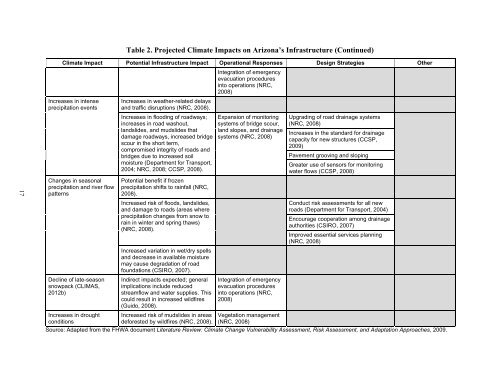SPR-696: Preliminary Study of Climate Adaptation for the Statewide ...
SPR-696: Preliminary Study of Climate Adaptation for the Statewide ...
SPR-696: Preliminary Study of Climate Adaptation for the Statewide ...
Create successful ePaper yourself
Turn your PDF publications into a flip-book with our unique Google optimized e-Paper software.
Table 2. Projected <strong>Climate</strong> Impacts on Arizona’s Infrastructure (Continued)<strong>Climate</strong> Impact Potential Infrastructure Impact Operational Responses Design Strategies O<strong>the</strong>rIntegration <strong>of</strong> emergencyevacuation proceduresinto operations (NRC,2008)17Increases in intenseprecipitation eventsChanges in seasonalprecipitation and river flowpatternsDecline <strong>of</strong> late-seasonsnowpack (CLIMAS,2012b)Increases in droughtconditionsIncreases in wea<strong>the</strong>r-related delaysand traffic disruptions (NRC, 2008).Increases in flooding <strong>of</strong> roadways;increases in road washout,landslides, and mudslides thatdamage roadways, increased bridgescour in <strong>the</strong> short term,compromised integrity <strong>of</strong> roads andbridges due to increased soilmoisture (Department <strong>for</strong> Transport,2004; NRC, 2008; CCSP, 2008).Potential benefit if frozenprecipitation shifts to rainfall (NRC,2008).Increased risk <strong>of</strong> floods, landslides,and damage to roads (areas whereprecipitation changes from snow torain in winter and spring thaws)(NRC, 2008).Increased variation in wet/dry spellsand decrease in available moisturemay cause degradation <strong>of</strong> roadfoundations (CSIRO, 2007).Indirect impacts expected; generalimplications include reducedstreamflow and water supplies. Thiscould result in increased wildfires(Guido, 2008).Increased risk <strong>of</strong> mudslides in areasde<strong>for</strong>ested by wildfires (NRC, 2008).Expansion <strong>of</strong> monitoringsystems <strong>of</strong> bridge scour,land slopes, and drainagesystems (NRC, 2008)Integration <strong>of</strong> emergencyevacuation proceduresinto operations (NRC,2008)Vegetation management(NRC, 2008)Upgrading <strong>of</strong> road drainage systems(NRC, 2008)Increases in <strong>the</strong> standard <strong>for</strong> drainagecapacity <strong>for</strong> new structures (CCSP,2009)Pavement grooving and slopingGreater use <strong>of</strong> sensors <strong>for</strong> monitoringwater flows (CCSP, 2008)Conduct risk assessments <strong>for</strong> all newroads (Department <strong>for</strong> Transport, 2004)Encourage cooperation among drainageauthorities (CSIRO, 2007)Improved essential services planning(NRC, 2008)Source: Adapted from <strong>the</strong> FHWA document Literature Review: <strong>Climate</strong> Change Vulnerability Assessment, Risk Assessment, and <strong>Adaptation</strong> Approaches, 2009.
















